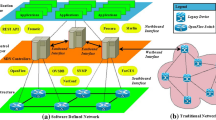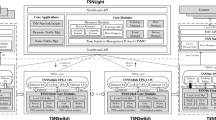Abstract
Efforts are underway to enhance the Internet with Quality of Service (QoS) capabilities for transporting real‐time data. The issue of wireless networks and mobile hosts being able to support applications that require QoS has become very significant. The ReSerVation Protocol (RSVP) provides a signaling mechanism for end‐to‐end QoS negotiation. RSVP has been designed to work with wired networks. To make RSVP suitable for wireless networks, changes need to be made by: (i) changing the way control messages are sent, and (ii) introducing wireless/mobile specific QoS parameters that take into account the major features of wireless networks, namely, high losses, low bandwidth, power constraints and mobility. In this paper, an architecture with a modified RSVP protocol that helps to provide QoS support for mobile hosts is presented. The modified RSVP protocol has been implemented in an experimental wireless and mobile testbed to study the feasibility and performance of our approach. Class Based Queueing (CBQ) which is used as the underlying bandwidth enforcing mechanism is also modified to fit our approach. The experimental results show that the modified RSVP and CBQ help in satisfying resource requests for mobile hosts, after handoff occurs. The experiments also show how different power and loss profile mechanisms can be used with our framework. The system performance using the modified RSVP control mechanism is also studied.
Similar content being viewed by others
References
P. Agrawal, J.-C. Chen, S. Kishore, P. Ramanathan and K.M. Sivalingam, Battery power sensitive video processing in wireless networks, in: Proc. IEEE PIMRC’ 98, Boston, MA (September 1998).
AT&T WaveLAN PCMCIA User's Guide (October 1994).
Y Bernet, J. Binder, S. Blake, M. Carlson, E. Davies, B. Ohlman, D. Verma, Z. Wang and W. Weiss, A framework for differentiated services, IETF Draft, draft-ietf-diffserv-framework-00.txt (May 1998).
S. Blake, D. Black, M. Carlson, E. Davies, Z. Wang and W. Weiss, An architecture for differentiated services, IETF Draft, draftietf-diffserv-arch-01.txt (August 1998).
J.M. Boyce and R.D. Gaglianello, Packet loss effects on MPEG video sent over the public Internet, www.acm.org/ sigmm/MM98/electronic proceeding/boyce/index. html#intro (1998).
R. Braden, L. Zhang, S. Berson, S. Herzog and S. Jamin, Resource ReSerVation Protocol (RSVP), Version 1 Functional Specification, RFC 2205 (September 1997).
L. Breslau and S. Shenker, Best-effort versus reservations: A simple comparative analysis, in: Proc. ACM SIGCOMM, Vancouver, B.C. (September 1998) pp. 3–16.
S. Choi and K.G. Shin, A cellular wireless local area network with QoS guarantees for heterogeneous traffic, in: Proc. IEEE INFOCOM (April 1997) pp. 1032–1039.
S. Floyd and V. Jacobson, Link-sharing and resource management models for packet networks, IEEE/ACM Transactions on Networking 3 (August 1995) 365–386.
C. Fragouli, V. Sivaraman and M. Srivastava, Controlled multimedia wireless link sharing via enhanced class-based queuing with channelstate-dependent packet scheduling, in: Proc. IEEE INFOCOM, San Francisco, CA (April 1998) pp. 572–580.
D.J. Goodman, R.A. Valenzuela, K.T. Gayliard and B. Ramamurthi, Packet reservation multiple access for local wireless communications, IEEE Transactions on Communications 37 (August 1989) 885–890.
ITU-T Rec. H.263, Video coding for low bit rate communication (March 1996).
S. Lu, V. Bharghavan and R. Srikant, Fair scheduling in wireless packet networks, in: Proc. ACM SIGCOMM, Cannes, France (September 1997) pp. 63–74.
S. Lu, T. Nandagopal and V. Bhargavan, A wireless fair service algorithm for packet cellular networks, in: Proc. ACM MobiCom, Dallas, TX (October 1998) pp. 10–20.
I. Mahadevan and K.M. Sivalingam, An experimental architecture for providing QoS guarantees in mobile networks using RSVP, in: Proc. IEEE PIMRC’ 98, Boston, MA (September 1998).
I. Mahadevan and K.M. Sivalingam, An architecture for QoS guarantees and routing in wireless/mobile networks, in: Proc. ACM Intl. Workshop on Wireless Mobile Multimedia (WoWMoM), Dallas, TX (October 1998) pp. 11–20.
I. Mahadevan and K.M. Sivalingam, Quality of service in wireless networks using enhanced differentiated services approach, in: Proc. Intl. Conference on Computer Communications and Networks, Boston, MA (October 1999).
M. Naghshineh and A.S. Acampora, Design and control of microcellular networks with QoS provisioning for data traffic, in: Proc. International Conference on Communications (ICC), Dallas, TX (June 1996) pp. 249–256.
P. Pan and H. Schulzrinne, Staged refresh timers for RSVP, Global Internet 97 (November 1997).
P. Pan, H. Schulzrinne and R. Guerin, Staged refresh timers for RSVP, IETF Draft, draft-pan-rsvp-timer-00.txt
C. Perkins, IP mobility support, RFC 2002 (October 1996).
P. Ramanathan and P. Agrawal, Adapting packet fair queuing algorithms to wireless networks, in: Proc. ACM MobiCom, Dallas, TX (October 1998) pp. 1–9.
P. Ramanathan, K.M. Sivalingam, P. Agrawal and S. Kishore, Resource allocation during handoff through dynamic schemes for mobile multimedia wireless networks, in: Proc. IEEE INFOCOM, New York, NY (March 1999).
C.P.S. Shenker and R. Guerin, Specification of guaranteed quality of service, RFC 2212 (September 1997).
S. Singh, Quality of service guarantees in mobile computing, Computer Communications 19 (April 1996) 359–371.
K.M. Sivalingam, J.-C. Chen, P. Agrawal and M. Srivastava, Design and analysis of low-power access protocols for wireless and mobile ATM networks, Wireless Networks 6(1) (2000) 73–87.
M. Stemm and R.H. Katz, Measuring and reducing energy consumption of network interfaces in hand-held devices, IEICE Transactions on Fundamentals of Electronics, Communications, and Computer Science (August 1997).
A.K. Talukdar, B.R. Badrinath and A. Acharya, On accommodating mobile hosts in an integrated services packet network, in: Proc. IEEE INFOCOM (April 1997) pp. 1048–1055.
A.K. Talukdar, B.R. Badrinath and A. Acharya, MRSVP: A reservation protocol for an integrated services packet network with mobile hosts, Technical Report TR-337, Rutgers University.
J. Wroclawski, The use of RSVP with IETF integrated services, RFC 2210 (September 1997).
J. Wroclawski, Specification of the controlled-load network element service, RFC 2211 (September 1997).
L. Zhang, S. Deering, D. Estrin, S. Shenker and D. Zappala, RSVP: A new resource ReSerVation Protocol, IEEE Network 7 (September 1993) 8–18.
Author information
Authors and Affiliations
Rights and permissions
About this article
Cite this article
Mahadevan, I., Sivalingam, K.M. Architecture and experimental results for quality of service in mobile networks using RSVP and CBQ. Wireless Networks 6, 221–234 (2000). https://doi.org/10.1023/A:1019141631622
Issue Date:
DOI: https://doi.org/10.1023/A:1019141631622




